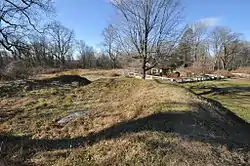Fort Stamford Site
The Fort Stamford Site, site of Fort Stamford, is a public park at 900 Westover Road in the Westover neighborhood of Stamford, Connecticut.[2][3] It was listed on the National Register of Historic Places in 1975.[1] It is the site of the archaeological remnants of a military earthworks erected during the American Revolutionary War.[4][5] The fort's location gave a clear view of the Mianus River and Long Island Sound.[6]
Fort Stamford Site | |
 View from atop the earthworks | |
  | |
| Location | Westover, Stamford, Connecticut |
|---|---|
| Coordinates | 41°5′6″N 73°34′42″W |
| Area | 5 acres (2.0 ha) |
| Built | 1781 |
| NRHP reference No. | 75001920[1] |
| Added to NRHP | September 10, 1975 |
History
American Revolution
During the Revolutionary War, Fort Stamford was created to aid in the defense of Connecticut from loyalist raids. The fort in its current form was designed by the engineer who constructed West Point, Rufus Putnam. General David Waterbury oversaw the construction in 1781.[7] At its peak, the fort was home to 800 soldiers.
Some form of military camp or fortification existed at the site prior to the construction of the current fort. During the February 26, 1779 raid on Greenwich by William Tryon, General Israel Putnam rode to Fort Stamford to rally reinforcements. Troops from the fort successfully defended Stamford in a battle near Palmer's Hill and the Mianus River.[8] On July 2, 1779 during Banastre Tarleton's raid on Pound Ridge, New York, the 2nd Regiment of Light Horse under Colonel Sheldon prevented the fort from being directly attacked.[9]
Later in the war, roughly 300 men manned the fort. When the war ended, the fort was considered no longer necessary, and was promptly sold.[10] In later years, residents of the neighborhood began referring to Fort Stamford as "Fort Nonsense."[11]
As a Private Residence
The area encompassing Fort Stamford was a private residence known as Fortland Farm, owned for some time by the Ogden family.[12]
In 1928, stockbroker Marcus Goodbody, founder of Goodbody & Co. moved his family to the property. His wife Virginia constructed the Italianate Garden that still stands on the property, now known as the Goodbody Garden.[13]
Fort Stamford Park
The City of Stamford purchased 5-acre property in 1972 from the Goodbody family, and the park features some of their garden structures in the formal Goodbody Garden maintained by the Stamford Garden Club.[14]
References
| Wikimedia Commons has media related to Fort Stamford. |
- "National Register Information System". National Register of Historic Places. National Park Service. March 13, 2009.
- State Commission on Culture & Tourism list
- "City of Stamford Park List" (PDF). Archived from the original (PDF) on 2011-07-20. Retrieved 2010-06-25.
- Roberts, Robert B. (1988). Encyclopedia of Historic Forts: The Military, Pioneer, and Trading Posts of the United States. New York: Macmillan. pp. 123–124. ISBN 0-02-926880-X.
- Fort Stamford at American Forts Network
- "Fort Stamford haunted by history, and maybe ghosts". Stamford Advocate. October 30, 2014. Retrieved 5 March 2017.
- "Fort Stamford". Stamford Patch. Retrieved 22 December 2020.
- Mather, Frederic George (1913). The Refugees of 1776 from Long Island to Connecticut. Berkeley, California: The University of California. pp. 196–197.
- Gillespie, Edward T.W. (1892). [Picturesque Stamford Picturesque Stamford] Check
|url=value (help). Stamford, Connecticut: Gillespie Brothers. p. 91. - O'Conner, Kara (August 17, 2011). "Fort Stamford: The city's Revolutionary stronghold". The Stamford Times. Stamford, Connecticut.
- Root, Mary Philotheta (1901). Chapter Sketches, Connecticut Daughters of the American Revolution. New Haven, CT: Edward P Judd Co. p. 434.
- Summer Social Register. New York, New York: The Social Register Association. 1911. p. 213.
- "Fort Stamford's Secret Garden". Stamford Patch. May 5, 2011. Retrieved 5 March 2017.
- "Goodbody Family 1928-1970". Stamford Garden Club. Retrieved 22 December 2020.